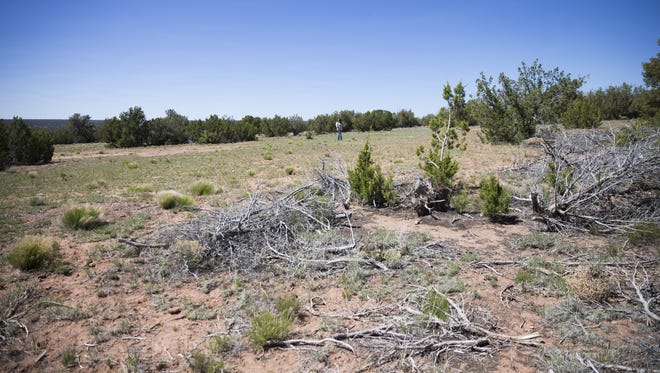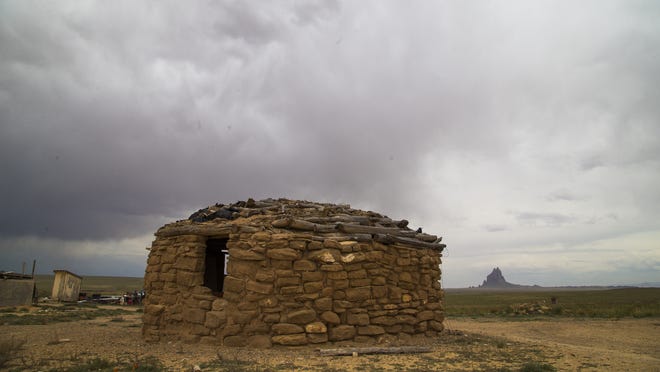“This housing is lower quality than tents or shacks, and may be interpreted to indicate a possibly desperate situation,” concluded the 2011 report by RPI Consulting of Colorado.
The Republic reviewed housing records from the NHA to calculate how many homes have actually been built since 1998. In the final accounting, it was clear why the numbers weren’t getting better.
The Housing Authority had been spending money for 18 years to chip away at the need.
And each year, on average, it built 235 dwellings. Not one home or rental unit was built from 2008 to 2011.
NHA Chief Executive Aneva “AJ” Yazzie was appointed in 2007, inheriting what she says was a dysfunctional organization.
An industrial engineer with federal and state housing experience, Yazzie was raised on the reservation in a two-room homestead with no running water or electricity.
After nine years as the NHA’s leader, she says the lack of progress stems from entrenched obstacles to tribal development, but also from HUD’s failed oversight prior to her administration.
Projects were in such disarray she put a temporary moratorium on building. And then it took years to evaluate the tribe’s housing needs, reform the NHA, plan for the future and clean up old messes.
“There’s a process, yet I keep doing the Whac-A-Mole,” Yazzie says. “It’s been a constant crisis mode. … I wanted to quit so many times. I thought, ‘I’ve gotten in too deep.’ I just kept trudging forward.”
The bottom line: No more than 758 residences have been built under Yazzie’s leadership, records show.
New residences accounted for about 30 percent of the NHA’s spending.
The rest of the money spent went to new administrative offices, planning, youth facilities and to refurbish or maintain existing NHA homes across the reservation.
But much of the cash languished, unspent.
Each year, tribes must tell federal authorities how much of their NAHASDA money they plan to spend and save, partly to ensure the funds are properly used.
Nearly two decades of financial reports show the NHA misreported its anticipated spending year after year by tens of millions of dollars.
In 2011, for example, the NHA projected expenditures of $88 million — all of that year’s federal housing allotment. But in a follow-up, the authority reported “no activities or projects have been implemented.”
Some tribes intentionally accrue funding while they plan major developments. But none comes close to the Navajo Housing Authority’s surplus. At one point, it had amassed nearly $500 million.
The most recent federal records available show tribes nationwide had a combined $787 million of unspent housing funds as of early September.
Tomasita Duran, executive director of the Ohkay Owingeh Housing Authority in northern New Mexico, said the Navajo surplus remains a sore point with some smaller Indian nations that have to cobble HUD money together with other funds just to build a few homes.
“It’s a little frustrating when you hear about the Navajos, with their millions that they get and the money not being spent,” Duran said. “We understand there is a dire need and they are much larger than other tribes, but for the amount of money they are getting, why are their needs not met?”
Yazzie said the NHA has a plan to spend down the entire surplus, which was drawn down to $234 million as of early November. She noted that $152 million was expended this past year.
How that money is being spent is less than clear.
The NHA’s 2016 annual report, filed in early December, does not have precise breakdowns of how much was spent on each housing project and there is not a detailed budget on how nearly $15 million was spent for planning and administration.

One significant investment was expected to be a 200-home community in Houck, where the NHA is planning a grand neighborhood of single-family houses, apartments, group homes, parks, trails and a community center.
A groundbreaking ceremony was staged in August 2014, and construction was supposed to start last year. But the Houck project is behind schedule and on hold.
Locals say there’s no drinkable water supply, and few qualified Navajos have shown an interest in moving to a rural outpost with no jobs or stores.
Yazzie said the design phase of the development is 95 percent complete, and the infrastructure is sufficient for electrical and water needs.
As unspent funds built up, so did the ire of some members of Congress.
They demanded to know why the money was not being used. And, unsatisfied with the answers, some pushed legislation to cut the Navajos’ allocation and give more to other tribes.
“How can cash just be sitting in their account for years? Who is that helping?” asks Rep. David Schweikert, R-Ariz.
Some Tribal Council members also lost patience, in part because of threatened federal cutbacks, but also because they’ve seen people like Begay suffer from decade-long housing waits — if they bothered applying.
“We’re not spending money for things we need — desperately need — and those are homes,” says Navajo Nation President Russell Begaye, who grew up in Shiprock.
“No more excuses. No more saying it’s because of deadlines or because of federal regulations,” Begaye said. “Build those homes.”
The NHA previously has survived efforts by the Tribal Council to take over housing funds and development. This year, delegates introduced another measure. It calls for the removal of the NHA as the tribe’s federally designated housing entity, effectively shutting down the organization. However, it has not passed.
HUD Secretary Julian Castro recently told The Republic he looks forward to working with the NHA to get homes built for Navajos.
”I believe the Navajo Nation wants to do the right thing.” Castro said. “They have taken some steps to do the right thing …”
Rick Lazio, a former New York congressman who wrote the NAHSDA legislation, said it’s brought progress to Indian country, but not without stumbles.
“NAHSDA is a significant step forward, but there are still huge underlying problems,” Lazio said. “There’s still not a lot of experience in terms of building a public infrastructure that is accountable and works.”
Lazio, now an affordable-housing lawyer, said the Navajos could use some outside experts on training and technology.
Sometime after the colorful roofs went up and garage doors were hung in Shiprock Estates, construction suddenly stopped.
Carletta Begay wondered, what’s going on?
In the background, far from her neighborhood, an audit and a criminal case unfolded.
HUD’s inspector general was investigating then-NHA Executive Director Chester Carl, who ran the agency for more than a decade before Yazzie.
In 2009, a federal grand jury indicted Carl as well as William Aubrey, who owned Lodgebuilder Inc., the company that built the homes in Shiprock and elsewhere.
Prosecutors alleged Aubrey diverted federal money from the housing projects to himself, using it for gambling, horse racing, furs, jewelry and for paying bribes to Carl.
The NHA shut down the Shiprock project, $11.75 million already spent.
Aubrey was found guilty of misappropriating funds and was sentenced to 4½ years in prison. Carl denied taking payoffs and was acquitted.
The houses sat empty.
After a while, crews put up chain-link fences to keep trespassers out. Vandals broke in anyway.
The new toilets and plumbing fixtures were carted off, stolen one by one. Teenagers skipping class used the houses as hangouts.
Squatters moved in, escaping the cold. Fires started. Some houses burned down. Others stood, charred shells of a project.
Begay was bewildered why so many houses were mostly built and then just abandoned. What if they had let families move in and finish the work themselves? What was going to happen to them?
One day a few years ago, she looked out across the neighborhood and saw what the Housing Authority was going to do with the houses.
Bulldozers had arrived.
Crews knocked down the stucco walls and the garage doors and hauled away the debris. They dug the water lines out of the ground. They tore out the concrete foundations.
They bladed everything down to the dirt, including driveways.
Begay wondered why they didn’t even leave a concrete slab. It could have been used as a basketball court.
By the time the NHA was finished tearing down the houses, it had spent another $1 million on demolition.
Yazzie, the NHA director, said it had to be done: The homes were in such bad shape they were a potential health hazard to the community.
HUD eventually assessed a nearly $12 million penalty, saying the NHA failed to use the money as required for “eligible affordable housing activities.”
The Housing Authority paid that penalty in the face of a HUD threat to involve the Justice Department.
In a 2014 letter to HUD, Yazzie protested, “There is no genuine effort to truly understand the unique and difficult issues we face, nor is there a sincere attempt to come up with a better workable solution.”
Today, a single house with a slanted roof and garage remains in Shiprock Estates. Among the 91 erected years ago, this one was rebuilt with insurance money after a fire. Today, it stands as a lone reminder of what might have been.
According to HUD records, the family living there does not qualify for low-income housing.
Begay, her husband and four daughters had moved across the neighborhood in 2006 to another flat-roofed rental, where termites crawl up through holes in the floor. They still live there, paying $650 a month to the project manager.
Out her back window, Begay sees bare earth where several of the 90 homes once stood.
She leads a tour of the area. All that remains are curb cuts, hints of driveways that once were there.
No one ever put up street signs.
“They should have stuck with the plan,” Begay says. “Instead, they just got everyone’s hopes up. … A total waste.”
Reach the reporters atcraig.harris@arizonarepublic.com and on Twitter @charrisazrep, and dennis.wagner@arizonarepublic.com and on Twitter @azrover.

